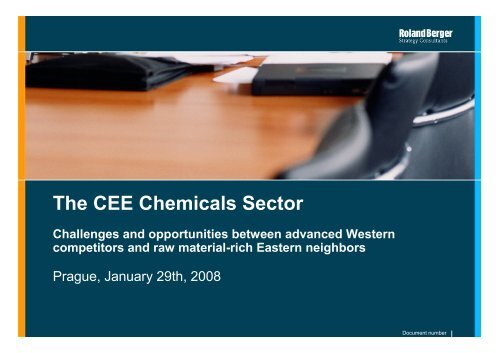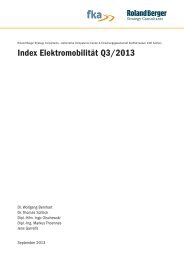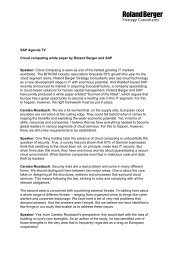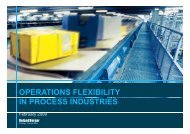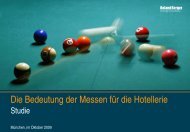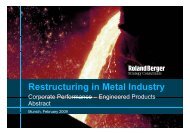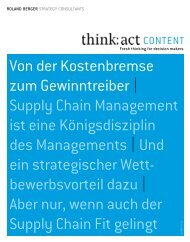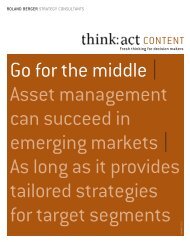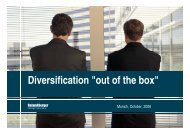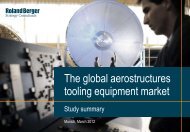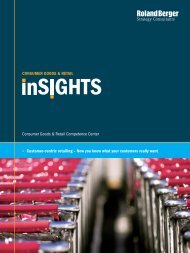The CEE Chemicals Sector - Roland Berger
The CEE Chemicals Sector - Roland Berger
The CEE Chemicals Sector - Roland Berger
- No tags were found...
Create successful ePaper yourself
Turn your PDF publications into a flip-book with our unique Google optimized e-Paper software.
<strong>The</strong> <strong>CEE</strong> <strong>Chemicals</strong> <strong>Sector</strong>Challenges and opportunities between advanced Westerncompetitors and raw material-rich Eastern neighborsPrague, January 29th, 2008Document number 1
<strong>Chemicals</strong> in <strong>CEE</strong> today and tomorrow –Five main thesis12345Alike Western competitors, <strong>CEE</strong> Chemical Industry is laggingdomestic raw material resourcesAt the same time, Eastern competitors with cheap feedstock have thepotential to more aggressively entering the marketsDeveloping a more value added portfolio with less feedstockdependency, <strong>CEE</strong> Chemical Industry has to rely on itselfAlbeit, attractive domestic markets offer opportunities for <strong>CEE</strong>companies, now setting the right courseIn that context, only strategic development combined with bestpracticeoperational excellence ensures sustainable successSource: <strong>Roland</strong> <strong>Berger</strong> Strategy ConsultantsDocument number 2
1From a global perspective, <strong>CEE</strong> is feedstock-wise inthe same position as Western EuropeGlobal feedstock resources [% of total reserves]13.64.22.62.8 4.351.927.24.66.12.53.42.941.54.1Total reservesOil:Natural gas:1,318 bn bbl1,101 bn bblMajor areas of OIL feedstock (>2.5% of global feedstock)Source: Oil&Gas Journal 2006, <strong>Roland</strong> <strong>Berger</strong> Strategy ConsultantsMajor areas of GAS feedstock (>2.5% of global feedstock)Document number 4
1In fact <strong>CEE</strong> sources most of its oil and gas fromRussia, being much more dependent than the EU15Oil and gas sources in <strong>CEE</strong> and EU15Sources oil 1)2) /gas in <strong>CEE</strong>[m t/bn cbm]Sources of oil 1)2) /gas in EU15[m t/bn cbm]5564605449Within regionOther importsRussia26% 28%12%19%62%53%Oil 3) GasWithin regionOther importsRussia10%62%29%Oil26%54%19%Gas1) 2005 2) Feedstock in form of crude, NGL, others 3) PL, CZ, HU, RO, SVSource: IEA, ENI World Oil & Gas review 2007, <strong>Roland</strong> <strong>Berger</strong> Strategy ConsultantsDocument number 5
1Coming from a similar position, Western Europeancompanies successfully managed the challengeOutput EU15 Chemical Industry 1) [bn EUR]Total: 451 (in 2006)Industrial gases FertilizersPaints & inksOther basic3% 8% Crop protectioninorganics 6%2%2%Other specialty17% chemicalsPetrochemicalsMan-madefibres22%2%23%Plastics & Synthetic rubber6% Soaps &8%detergentsPerfumes & cosmeticsComments• High feedstock dependencybalanced by own gas/oilaccess, e.g. BASF, Yara• Margins increased bymarketing efforts, valueaddedservices, optimizedlogistics, etc.• Added-value product portfoliodeveloped with specialties,customized services andsystem houses, e.g.ALTANA, DSM, Bayer, BASFSpecialty <strong>Chemicals</strong> Consumer <strong>Chemicals</strong> Base <strong>Chemicals</strong>1) Shares of output for total EU – as EU 15 account for more than 95% only little influence of Rest of EUSource: Cefic 2007, <strong>Roland</strong> <strong>Berger</strong> Strategy ConsultantsDocument number 6
2Feedstock is the main cost driver in the productionof commodity chemicalsSchematic cost distribution of commodities [%]100FinalCosts512EH&S,SG&AAdvertising4DepreciationMaintenance,R&D11Labor67RawMaterials,EnergyComments• Feedstock prices have a verysignificant impact on the finalcosts• <strong>The</strong> processing costs arequite fix for the producers inone region• <strong>The</strong>refore a spread infeedstock prices acrossregions has a strong impacton price competitiveness onglobal marketsSource: American Chemical Society, <strong>Roland</strong> <strong>Berger</strong> Strategy ConsultantsDocument number 8
2Russia has the potential to leverage low feedstockcost into low raw material and intermediates costsFeedstock costs in Russia compared to other regions 2007Natural gas 1) [USD/mBTU]Product: methanol8.38.0Ethane [USD/t]Product: ethylene1024 2)Naphtha [USD/t]Product: olefins + aromatics675 3) 550 4) 480924 2) 1001.5WesternEuropeSingaporeSingaporeRussiaWesternEuropeSingaporeRussiaWesternEuropeRussia1) Second Quarter 20072) Q1-Q3 2007 3) cif 4) fobSource: American Chemistry Council, CMAI, Bloomberg, <strong>Roland</strong> <strong>Berger</strong> Strategy ConsultantsDocument number 9
2But currently, EU 15 dominates even commodityimports – What is Russia’s future role?Imports of <strong>Chemicals</strong> in 2006Chemical imports into <strong>CEE</strong>Total: about EUR 21,700 mOthersOrigin of commodity imports [m EUR]6,43613%30%Base <strong>Chemicals</strong>54%EU 15Plastics28%30%Specialties22% Intra <strong>CEE</strong>8% Russia16% Others8% ofcommodityimports fromRussia – so farSource: <strong>Roland</strong> <strong>Berger</strong> Strategy ConsultantsDocument number 10
Politics and management in Russia have discoveredthat topic as wellRussia plans six new major chemical plantsReuters, 21 November 2007Russia will build six major chemical plants by 2015 as it seeks to cut imports of value added products,including plastics, for booming industries such as the car sector, a minister said on Wednesday. Energy andIndustry Minister Viktor Khristenko said the government wanted the share of the chemical industry to rise to 3percent of gross domestic product by 2015, from 1.7 percent now, under a strategy reviewed at a cabinet meeting.<strong>The</strong> ratio of value-added chemical products to basic chemical materials should rise to 70 to 30 by 2015 from thecurrent 30 to 70, he said.…INTERVIEW: Expansion the only way Russia can compete: Sibur chiefPlatts Petrochemical Report (c) 2007 McGraw-Hill, Inc., 13 July 2007…Russia is well positioned in the global petrochemical industry, Konov said in London, July 4. <strong>The</strong> country isblessed with an the abundance of low-cost natural gas feedstock (21.3% of the world's natural gas production in2006, the largest in that year, came from Russia, according to BP's latest statistical studies).And Russia's geographical location means easy access to the export markets of Northwest Europe andAsia. But Russia lacks the economies of scale to compete effectively in the global petrochemical arena.Source: Press research, <strong>Roland</strong> <strong>Berger</strong>Document number 11
2Import pressure form eastern competitors mightincrease• <strong>CEE</strong> <strong>Chemicals</strong> Industry needs to import oil and gas at market price• Below-market local price gives Russian players cost advantage, sofar leading to EU-Anti-dumping regulation (esp. fertilizers)• Increasing feedstock prices reduce Russian margins, but also softenAnti-dumping• In addition, Russian companies have significant headroom toincrease competitiveness by modernization and up-scaling• Import pressure can potentially increase if– Russian domestic demand falls behind expectations– Russian capacity expansions are coming on stream and– other exports lack profitabilitySource: <strong>Roland</strong> <strong>Berger</strong> Strategy ConsultantsDocument number 12
3<strong>The</strong> lion share of high value chemicals is imported,mostly by Westerners<strong>CEE</strong> 1) market supply of specialty/fine chemicals in 2006Supply structure Specialty/Fine chemicalsSplit of imports by countryTotal: about 9.3 EUR bnDomestic production30%54%54% EU 15 imports32%8%9%12%OtherItalyNetherlandsFrance54% of highvaluemarketimported byWesterners,thereof nearlyhalf fromGermany16%40%GermanyOthers imports1) Pl, CZ, HU, RO, SL, SKSource: Eurostat, <strong>Roland</strong> <strong>Berger</strong> analysisDocument number 14
3<strong>The</strong> dramatic growth of imports shows, that marketopportunities were not captured by locals so farImports of <strong>Chemicals</strong> in <strong>CEE</strong>Origin of high-value chemicals [EUR m]CommentsOther RegionsWithin regionEU 153,7385272,907304+73%5,7064088554,4436,4774709915,016• <strong>The</strong> imports in high-valuechemicals into the <strong>CEE</strong> regiongrew significantly stronger thanGDP growth• Most of the growth is coveredby Western Europeancompanies – making up 77% by2006• <strong>The</strong>refore the domesticcompanies lost market share,despite growth, in this segment200420052006Source: Eurostat, <strong>Roland</strong> <strong>Berger</strong> analysisDocument number 15
3Also, there is no indication for capacity build up ofWestern chemicals companiesFDIs in <strong>CEE</strong> by sectorCumulative FDI 2005-2006 1) [m EUR]Selected top investments 2005/2006[m EUR]Total: 57,000<strong>Chemicals</strong>4%Manufacturing19%CompanyErste Bank (RO)Hyundai (CZ)OMV (RO)Volume2,2001,060833IndustryFinancial ServicesAutomotiveOilRWE (HU)724PowerHankook (HU)525ManufacturingOthers56%14%TradeRenault (RO)Bridgestone (PL)215200AutomotiveManufacturingDell (PL)200ElectronicsSharp (PL)200Electronics1) PL, CZ, ROSource: <strong>Roland</strong> <strong>Berger</strong> Strategy ConsultantsDocument number 16
3Many Western Chemical companies are present in<strong>CEE</strong>, but have limited production activities hereActivities of selected Western Chemical companies – Example PolandCompany<strong>The</strong> Chemical CompanyActivities in Poland4 local sales offices, production site for constructions chemicals in Poznan, production sitefor admixtures in MysleniceProduction site for Nutritional Products in Mszczonów, 2 sales offices in Warsaw2 local sales offices (Lazy office equipped with laboratory and warehouse)Production site for Advanced Fillers & Pigments Business Unit, and sales office withresponsibilities for 11 of 12 Business Units in the regionProduction site for Coatings in Wloclawek and 2 R&D facilities (Industrial finishes, Coatings),5 sales officesLocal powder coatings enterprise, other products via sales agentsNo direct activities – 2 product groups handled by non-Polish Lanxess sales companies;others via sales agentsSource: Company information, <strong>Roland</strong> <strong>Berger</strong> Strategy ConsultantsDocument number 17
4First of all - <strong>CEE</strong> is a growth region offeringbusiness opportunitiesEstimated GDP growth '05-'10 [% p.a.]Technology index 1) 2006PLRO4.65.5Average upside potential for <strong>CEE</strong> marketsWestern European countries4.494.19Ø 3.70 <strong>CEE</strong>countries in EU3.704.71CZHU3.54.3Ø 3.11 <strong>CEE</strong> coutries 2)2.97Ø 2.44 <strong>CEE</strong>- outside EU2.252.57SL3.81.62SK5.9EU 152.2BIH UK HR PL HU CZ SV GER<strong>CEE</strong> countries outside EU <strong>CEE</strong> countries in EU Western European countriesBIH = Bosnia & Herzegovina, UKR = Ukraine, HRO = Croatia, POL = Poland, HUN = Hungary, CZR = Czech Republic, SVN = Slovenia;1)Technology Index as proxy for economic and socio-political indicators with scale from 1 (Min.) to 6 (Max.) 2) 15 <strong>CEE</strong> countries investigatedSource: <strong>Roland</strong> <strong>Berger</strong> Strategy ConsultantsDocument number 20
4Not to forget commodities – With fulfillment of keysuccess criteria <strong>CEE</strong> companies can competeCommodity success criteria by <strong>CEE</strong> Chemical Industry 1)Success criteria Fulfillment 1)Strength in domestic marketHigh production efficiencyEconomies of ScaleStrong customer relationUsage of marketing toolsOffer of value servicesComments• In the recent past the ChemicalIndustry has identified the rightissues• <strong>The</strong> Chemical Industry alreadytackled many success factors• Also, customers will becomemore professional in theirdemands and purchaseaccordingly• <strong>The</strong>refore, further improvementis possible and needed1) Fulfillment of <strong>CEE</strong> <strong>Chemicals</strong> Industry in generalSource: <strong>Roland</strong> <strong>Berger</strong> Strategy ConsultantsDocument number 21
4SCENARIOBut real growth potential for <strong>CEE</strong> Chemical Industrycomes from specialties…Business potential in chemicals in <strong>CEE</strong> (2007-2012)<strong>CEE</strong> commodity market [EUR m] <strong>CEE</strong> specialty market [EUR m]+4% p.a.+7% p.a.11,93413,9509,4322,996+ 8233,819 1)9,3002,790+ 4,6507,440 2)6,4368,1156,5106,5102006201220062012Imports into <strong>CEE</strong> markets Domestic production in <strong>CEE</strong> markets1) Market share of <strong>CEE</strong> commodity producers remains constant 2) Keeping imports on current levelSource: <strong>Roland</strong> <strong>Berger</strong> Strategy ConsultantsDocument number 22
4… and the <strong>CEE</strong> Chemical Industry has allcapabilities to tab into these market opportunities• Supported by EU accession, markets in <strong>CEE</strong> represent a consistenteconomic area with sufficient size and considerable growth• <strong>CEE</strong> companies hold strong domestic positions already for selectedproducts (e.g. TiO 2 , Soda, MDI, TDI)• <strong>CEE</strong> has the great advantage of a highly qualified and motivatedworkforce, as well as solid experience and tradition in chemicals• Nevertheless, the growth opportunities in commodities and valueaddedchemicals are very different and demand for distinct andselective approachesSource: <strong>Roland</strong> <strong>Berger</strong> Strategy ConsultantsDocument number 23
5Relative turnover and output in <strong>CEE</strong> are improving,providing increasing competitivenessEfficiency and growth of chemical industryTurnover per employee ['000 EUR]Chemical output growth 2005-2015 [% p.a.]355508Share in production[%]1.5212125301111735207796.46.04.94.32.62.11.820052015EU <strong>CEE</strong> RussiaMiddleEastAsia w/oJPN<strong>CEE</strong>RussiaNAFTAEU15JPN• Old production facilities and historical highemployment rates are major reasons for lowturnover per employee• Nevertheless, comparable low salaries in <strong>CEE</strong>/ CISprovide cost competitiveness• Besides Asia and Middle East, <strong>CEE</strong>/CIS are major growthdrivers in chemical industry, but overall market share is stillsmall• <strong>CEE</strong>/CIS is benefiting from production off-shoring of basechemicals from Western European locationsSource: <strong>Roland</strong> <strong>Berger</strong> Strategy ConsultantsDocument number 25
5To sustain success gained competitiveness has tobe levered with strategic developmentStrategic consolidationReshaping of product portfolio• Regional champions with strong financialpositions should try to drive consolidation• <strong>The</strong> <strong>Chemicals</strong> Industry is very fragmentedin <strong>CEE</strong>, leaving interesting targets in themarket• Western players will stay away• Establishment of reliablelong-term partnerships in thedomestic market– either along the value chain or– with competitor for distribution, etc.• Cross-country partnershipsSelective partnershipsStrategicdevelopmentoptions in chemicalsin <strong>CEE</strong>• Dependency of commodities crucial for the<strong>CEE</strong> Chemical Industry• Evaluation of vertical moves in the valuechain to increase margins and reduce rawmaterial dependency• Organization and processesneeds to be reshaped• Technological efficiency measures have tobe employed in depth• Marketing/Sales experience of Westerners tobe benchmarked and implementedOperational ExcellenceSource: <strong>Roland</strong> <strong>Berger</strong> Strategy ConsultantsDocument number 26
ConclusionI<strong>CEE</strong> will be an attractive region for the Chemical Industry, despitemissing raw material accessIIIn commodities sustainable long-term success is possible byconcentration on domestic marketsIIIIn value-added chemicals real growth opportunities will arise by thesubstitution of importsIVAnyway, strategic consolidation and operational excellence areneeded to translate opportunities into successSource: <strong>Roland</strong> <strong>Berger</strong> Strategy ConsultantsDocument number 28


